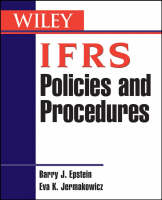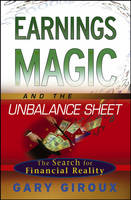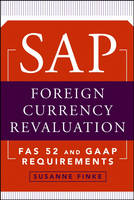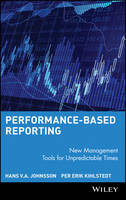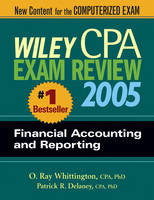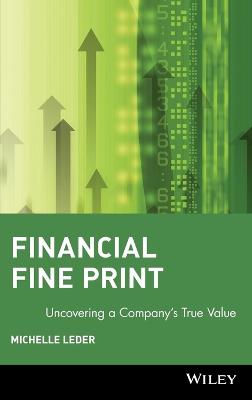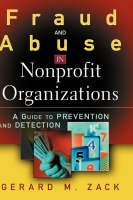Fair Value for Financial Reporting
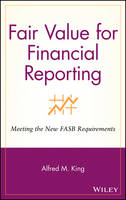 -15%
portes grátis
-15%
portes grátis
Fair Value for Financial Reporting
Meeting the New FASB Requirements
King, Alfred M.
John Wiley & Sons Inc
06/2006
352
Dura
Inglês
9780471771845
15 a 20 dias
672
Descrição não disponível.
PREFACE. CHAPTER 1. Impact of Fair Value on Earnings Per Share.
Fundamentals of SFAS 141R.
Developing Fair Value in a Business Combination.
How an Appraiser Looks at Intangibles.
Intended Use of Intangible Assets: "Market Participants".
Estimated Life of Assets.
Impact on Earnings Per Share of Fair Value Calculations.
Conclusion.
CHAPTER 2. What Is Fair Value?
Purpose of an Appraisal.
Three Different Values Do Not Disprove Appraiser Integrity.
Why Two Appraisers Provide Different Results.
Importance of Assumptions.
Evaluating an Appraisal Report.
Accuracy of Appraisal Reports.
Conclusion.
CHAPTER 3. What Is Fair Value Reporting?
FASB Leads the Way.
Balance Sheet versus Income Statement.
Changes in Balance Sheets Measure Income.
Unrealized Gains Can Be Manipulated to Create Income.
Should We Have Fair Value?
Volatility.
Concepts Statement 7.
FASB's Fair Value Proposals.
Conclusion.
CHAPTER 4. How Appraisers Develop Fair Value.
Basic Valuation Principles.
Use of the Three Approaches.
Correlating the Answer.
Value In-Use versus Value In-Exchange.
What Is Value In-Use?
What Is Value In-Exchange?
FASB's Dilemma.
Can Fair Value Be Audited?
Market Participants.
Income Taxes and Subchapters Considerations in Valuation.
Selecting an Appraiser.
Conclusion.
CHAPTER 5. Allocation of Purchase Price (SFASs 141R and 142).
Is the Purchase Price Equal to Fair Value?
Testing Fair Value.
Weighted Average Cost of Capital.
Synergies.
Comparing SFAS 141R with Its Predecessor, SFAS 141.
Transaction Costs.
Contingent Consideration.
Fair Value of Equity Securities Issued.
Contingent Assets and Liabilities.
Restructuring Costs.
Identifying Specific Intangible Assets.
Unpatented Technology.
Backlog.
Assembled Workforce.
Bargain Purchases.
Partial Acquisitions and Noncontrolling Interests.
Conclusion.
CHAPTER 6. Determining the Fair Value of Intangible Assets.
Trademarks, Trade Names.
Internet Domain Names.
Noncompetition Agreements.
Customer Lists and Customer Relationships.
Customer Relationships.
Franchise Agreements.
Operating and Broadcast Rights.
Patented and Unpatented Technology.
Software.
Software Developed for Sale to Others.
Conclusion.
CHAPTER 7. Valuation of Liabilities and Contingent Payments.
FASB's New Approach to Liabilities: "Expected Value".
Estimating and Valuing Legal Liabilities.
Valuing Environmental Liabilities.
Valuation of Contingent Purchase Price.
Conclusion.
CHAPTER 8. Testing for Impairment.
Testing Goodwill for Impairment.
Valuing Reporting Units.
Phase 2: Implied Goodwill.
Testing Identifiable Intangibles with an Indefinite Life.
Testing Identifiable Intangibles with a Definite Life.
Impairment of Property, Plant, and Equipment.
Conclusion.
CHAPTER 9. Valuation of Hard Assets and Real Estate.
Highest and Best Use.
Value In-Use versus Value In-Exchange.
Physical Inspection and the Condition of Assets.
Accounting Depreciation versus Appraisal Depreciation.
Negative Goodwill.
Hierarchy of Earnings.
Assets Held for Sale.
What to Do About Undervalued Assets.
Sarbanes-Oxley Required Controls on PP&E.
Size of the PP&E Problem.
Controlling PP&E.
A Perfect Solution.
A Workable Solution.
Minimum Capitalization Amounts Should Be Raised.
Conclusion.
CHAPTER 10. In-Process Research and Development.
Cost versus Value.
Development of In-Process Research and Development.
Valuation of IPR&D.
Conclusion.
CHAPTER 11. Valuation of Inventories and Receivables.
True Cost of Inventory.
LIFO: Half of Fair Value.
Net Realizable Value.
Selling Expenses.
What Is a "Reasonable Profit"?
Work-in-Process and Raw Materials.
Inventory Obsolescence.
Summary of Fair Value of Inventories.
Valuation of Receivables.
Summary of Fair Value of Receivables.
Conclusion.
CHAPTER 12. Valuing Stock Options.
Valuation of Options Under SFAS 123R.
Seven Variables of Option Valuation.
Valuation Methodology for Stock Options.
Developing Supportable Assumptions for the Valuation.
Conclusion.
CHAPTER 13. Auditing of Valuation Reports and Selecting an Appraiser.
Be Careful What You Ask For!
Auditor Review of Valuation Reports.
Every Appraisal Has at Least One Key Assumption.
How to Choose an Appraiser.
Obtaining and Evaluating Proposals for Valuation.
Conclusion.
INDEX.
Fundamentals of SFAS 141R.
Developing Fair Value in a Business Combination.
How an Appraiser Looks at Intangibles.
Intended Use of Intangible Assets: "Market Participants".
Estimated Life of Assets.
Impact on Earnings Per Share of Fair Value Calculations.
Conclusion.
CHAPTER 2. What Is Fair Value?
Purpose of an Appraisal.
Three Different Values Do Not Disprove Appraiser Integrity.
Why Two Appraisers Provide Different Results.
Importance of Assumptions.
Evaluating an Appraisal Report.
Accuracy of Appraisal Reports.
Conclusion.
CHAPTER 3. What Is Fair Value Reporting?
FASB Leads the Way.
Balance Sheet versus Income Statement.
Changes in Balance Sheets Measure Income.
Unrealized Gains Can Be Manipulated to Create Income.
Should We Have Fair Value?
Volatility.
Concepts Statement 7.
FASB's Fair Value Proposals.
Conclusion.
CHAPTER 4. How Appraisers Develop Fair Value.
Basic Valuation Principles.
Use of the Three Approaches.
Correlating the Answer.
Value In-Use versus Value In-Exchange.
What Is Value In-Use?
What Is Value In-Exchange?
FASB's Dilemma.
Can Fair Value Be Audited?
Market Participants.
Income Taxes and Subchapters Considerations in Valuation.
Selecting an Appraiser.
Conclusion.
CHAPTER 5. Allocation of Purchase Price (SFASs 141R and 142).
Is the Purchase Price Equal to Fair Value?
Testing Fair Value.
Weighted Average Cost of Capital.
Synergies.
Comparing SFAS 141R with Its Predecessor, SFAS 141.
Transaction Costs.
Contingent Consideration.
Fair Value of Equity Securities Issued.
Contingent Assets and Liabilities.
Restructuring Costs.
Identifying Specific Intangible Assets.
Unpatented Technology.
Backlog.
Assembled Workforce.
Bargain Purchases.
Partial Acquisitions and Noncontrolling Interests.
Conclusion.
CHAPTER 6. Determining the Fair Value of Intangible Assets.
Trademarks, Trade Names.
Internet Domain Names.
Noncompetition Agreements.
Customer Lists and Customer Relationships.
Customer Relationships.
Franchise Agreements.
Operating and Broadcast Rights.
Patented and Unpatented Technology.
Software.
Software Developed for Sale to Others.
Conclusion.
CHAPTER 7. Valuation of Liabilities and Contingent Payments.
FASB's New Approach to Liabilities: "Expected Value".
Estimating and Valuing Legal Liabilities.
Valuing Environmental Liabilities.
Valuation of Contingent Purchase Price.
Conclusion.
CHAPTER 8. Testing for Impairment.
Testing Goodwill for Impairment.
Valuing Reporting Units.
Phase 2: Implied Goodwill.
Testing Identifiable Intangibles with an Indefinite Life.
Testing Identifiable Intangibles with a Definite Life.
Impairment of Property, Plant, and Equipment.
Conclusion.
CHAPTER 9. Valuation of Hard Assets and Real Estate.
Highest and Best Use.
Value In-Use versus Value In-Exchange.
Physical Inspection and the Condition of Assets.
Accounting Depreciation versus Appraisal Depreciation.
Negative Goodwill.
Hierarchy of Earnings.
Assets Held for Sale.
What to Do About Undervalued Assets.
Sarbanes-Oxley Required Controls on PP&E.
Size of the PP&E Problem.
Controlling PP&E.
A Perfect Solution.
A Workable Solution.
Minimum Capitalization Amounts Should Be Raised.
Conclusion.
CHAPTER 10. In-Process Research and Development.
Cost versus Value.
Development of In-Process Research and Development.
Valuation of IPR&D.
Conclusion.
CHAPTER 11. Valuation of Inventories and Receivables.
True Cost of Inventory.
LIFO: Half of Fair Value.
Net Realizable Value.
Selling Expenses.
What Is a "Reasonable Profit"?
Work-in-Process and Raw Materials.
Inventory Obsolescence.
Summary of Fair Value of Inventories.
Valuation of Receivables.
Summary of Fair Value of Receivables.
Conclusion.
CHAPTER 12. Valuing Stock Options.
Valuation of Options Under SFAS 123R.
Seven Variables of Option Valuation.
Valuation Methodology for Stock Options.
Developing Supportable Assumptions for the Valuation.
Conclusion.
CHAPTER 13. Auditing of Valuation Reports and Selecting an Appraiser.
Be Careful What You Ask For!
Auditor Review of Valuation Reports.
Every Appraisal Has at Least One Key Assumption.
How to Choose an Appraiser.
Obtaining and Evaluating Proposals for Valuation.
Conclusion.
INDEX.
Este título pertence ao(s) assunto(s) indicados(s). Para ver outros títulos clique no assunto desejado.
value; equal; price; fair; assets; fasb; liabilities; categories; requirements; increasing; current; shown; answers; questions; crystal clarity; pertinent; financial; top expert; field; deep; auditors; provides
PREFACE. CHAPTER 1. Impact of Fair Value on Earnings Per Share.
Fundamentals of SFAS 141R.
Developing Fair Value in a Business Combination.
How an Appraiser Looks at Intangibles.
Intended Use of Intangible Assets: "Market Participants".
Estimated Life of Assets.
Impact on Earnings Per Share of Fair Value Calculations.
Conclusion.
CHAPTER 2. What Is Fair Value?
Purpose of an Appraisal.
Three Different Values Do Not Disprove Appraiser Integrity.
Why Two Appraisers Provide Different Results.
Importance of Assumptions.
Evaluating an Appraisal Report.
Accuracy of Appraisal Reports.
Conclusion.
CHAPTER 3. What Is Fair Value Reporting?
FASB Leads the Way.
Balance Sheet versus Income Statement.
Changes in Balance Sheets Measure Income.
Unrealized Gains Can Be Manipulated to Create Income.
Should We Have Fair Value?
Volatility.
Concepts Statement 7.
FASB's Fair Value Proposals.
Conclusion.
CHAPTER 4. How Appraisers Develop Fair Value.
Basic Valuation Principles.
Use of the Three Approaches.
Correlating the Answer.
Value In-Use versus Value In-Exchange.
What Is Value In-Use?
What Is Value In-Exchange?
FASB's Dilemma.
Can Fair Value Be Audited?
Market Participants.
Income Taxes and Subchapters Considerations in Valuation.
Selecting an Appraiser.
Conclusion.
CHAPTER 5. Allocation of Purchase Price (SFASs 141R and 142).
Is the Purchase Price Equal to Fair Value?
Testing Fair Value.
Weighted Average Cost of Capital.
Synergies.
Comparing SFAS 141R with Its Predecessor, SFAS 141.
Transaction Costs.
Contingent Consideration.
Fair Value of Equity Securities Issued.
Contingent Assets and Liabilities.
Restructuring Costs.
Identifying Specific Intangible Assets.
Unpatented Technology.
Backlog.
Assembled Workforce.
Bargain Purchases.
Partial Acquisitions and Noncontrolling Interests.
Conclusion.
CHAPTER 6. Determining the Fair Value of Intangible Assets.
Trademarks, Trade Names.
Internet Domain Names.
Noncompetition Agreements.
Customer Lists and Customer Relationships.
Customer Relationships.
Franchise Agreements.
Operating and Broadcast Rights.
Patented and Unpatented Technology.
Software.
Software Developed for Sale to Others.
Conclusion.
CHAPTER 7. Valuation of Liabilities and Contingent Payments.
FASB's New Approach to Liabilities: "Expected Value".
Estimating and Valuing Legal Liabilities.
Valuing Environmental Liabilities.
Valuation of Contingent Purchase Price.
Conclusion.
CHAPTER 8. Testing for Impairment.
Testing Goodwill for Impairment.
Valuing Reporting Units.
Phase 2: Implied Goodwill.
Testing Identifiable Intangibles with an Indefinite Life.
Testing Identifiable Intangibles with a Definite Life.
Impairment of Property, Plant, and Equipment.
Conclusion.
CHAPTER 9. Valuation of Hard Assets and Real Estate.
Highest and Best Use.
Value In-Use versus Value In-Exchange.
Physical Inspection and the Condition of Assets.
Accounting Depreciation versus Appraisal Depreciation.
Negative Goodwill.
Hierarchy of Earnings.
Assets Held for Sale.
What to Do About Undervalued Assets.
Sarbanes-Oxley Required Controls on PP&E.
Size of the PP&E Problem.
Controlling PP&E.
A Perfect Solution.
A Workable Solution.
Minimum Capitalization Amounts Should Be Raised.
Conclusion.
CHAPTER 10. In-Process Research and Development.
Cost versus Value.
Development of In-Process Research and Development.
Valuation of IPR&D.
Conclusion.
CHAPTER 11. Valuation of Inventories and Receivables.
True Cost of Inventory.
LIFO: Half of Fair Value.
Net Realizable Value.
Selling Expenses.
What Is a "Reasonable Profit"?
Work-in-Process and Raw Materials.
Inventory Obsolescence.
Summary of Fair Value of Inventories.
Valuation of Receivables.
Summary of Fair Value of Receivables.
Conclusion.
CHAPTER 12. Valuing Stock Options.
Valuation of Options Under SFAS 123R.
Seven Variables of Option Valuation.
Valuation Methodology for Stock Options.
Developing Supportable Assumptions for the Valuation.
Conclusion.
CHAPTER 13. Auditing of Valuation Reports and Selecting an Appraiser.
Be Careful What You Ask For!
Auditor Review of Valuation Reports.
Every Appraisal Has at Least One Key Assumption.
How to Choose an Appraiser.
Obtaining and Evaluating Proposals for Valuation.
Conclusion.
INDEX.
Fundamentals of SFAS 141R.
Developing Fair Value in a Business Combination.
How an Appraiser Looks at Intangibles.
Intended Use of Intangible Assets: "Market Participants".
Estimated Life of Assets.
Impact on Earnings Per Share of Fair Value Calculations.
Conclusion.
CHAPTER 2. What Is Fair Value?
Purpose of an Appraisal.
Three Different Values Do Not Disprove Appraiser Integrity.
Why Two Appraisers Provide Different Results.
Importance of Assumptions.
Evaluating an Appraisal Report.
Accuracy of Appraisal Reports.
Conclusion.
CHAPTER 3. What Is Fair Value Reporting?
FASB Leads the Way.
Balance Sheet versus Income Statement.
Changes in Balance Sheets Measure Income.
Unrealized Gains Can Be Manipulated to Create Income.
Should We Have Fair Value?
Volatility.
Concepts Statement 7.
FASB's Fair Value Proposals.
Conclusion.
CHAPTER 4. How Appraisers Develop Fair Value.
Basic Valuation Principles.
Use of the Three Approaches.
Correlating the Answer.
Value In-Use versus Value In-Exchange.
What Is Value In-Use?
What Is Value In-Exchange?
FASB's Dilemma.
Can Fair Value Be Audited?
Market Participants.
Income Taxes and Subchapters Considerations in Valuation.
Selecting an Appraiser.
Conclusion.
CHAPTER 5. Allocation of Purchase Price (SFASs 141R and 142).
Is the Purchase Price Equal to Fair Value?
Testing Fair Value.
Weighted Average Cost of Capital.
Synergies.
Comparing SFAS 141R with Its Predecessor, SFAS 141.
Transaction Costs.
Contingent Consideration.
Fair Value of Equity Securities Issued.
Contingent Assets and Liabilities.
Restructuring Costs.
Identifying Specific Intangible Assets.
Unpatented Technology.
Backlog.
Assembled Workforce.
Bargain Purchases.
Partial Acquisitions and Noncontrolling Interests.
Conclusion.
CHAPTER 6. Determining the Fair Value of Intangible Assets.
Trademarks, Trade Names.
Internet Domain Names.
Noncompetition Agreements.
Customer Lists and Customer Relationships.
Customer Relationships.
Franchise Agreements.
Operating and Broadcast Rights.
Patented and Unpatented Technology.
Software.
Software Developed for Sale to Others.
Conclusion.
CHAPTER 7. Valuation of Liabilities and Contingent Payments.
FASB's New Approach to Liabilities: "Expected Value".
Estimating and Valuing Legal Liabilities.
Valuing Environmental Liabilities.
Valuation of Contingent Purchase Price.
Conclusion.
CHAPTER 8. Testing for Impairment.
Testing Goodwill for Impairment.
Valuing Reporting Units.
Phase 2: Implied Goodwill.
Testing Identifiable Intangibles with an Indefinite Life.
Testing Identifiable Intangibles with a Definite Life.
Impairment of Property, Plant, and Equipment.
Conclusion.
CHAPTER 9. Valuation of Hard Assets and Real Estate.
Highest and Best Use.
Value In-Use versus Value In-Exchange.
Physical Inspection and the Condition of Assets.
Accounting Depreciation versus Appraisal Depreciation.
Negative Goodwill.
Hierarchy of Earnings.
Assets Held for Sale.
What to Do About Undervalued Assets.
Sarbanes-Oxley Required Controls on PP&E.
Size of the PP&E Problem.
Controlling PP&E.
A Perfect Solution.
A Workable Solution.
Minimum Capitalization Amounts Should Be Raised.
Conclusion.
CHAPTER 10. In-Process Research and Development.
Cost versus Value.
Development of In-Process Research and Development.
Valuation of IPR&D.
Conclusion.
CHAPTER 11. Valuation of Inventories and Receivables.
True Cost of Inventory.
LIFO: Half of Fair Value.
Net Realizable Value.
Selling Expenses.
What Is a "Reasonable Profit"?
Work-in-Process and Raw Materials.
Inventory Obsolescence.
Summary of Fair Value of Inventories.
Valuation of Receivables.
Summary of Fair Value of Receivables.
Conclusion.
CHAPTER 12. Valuing Stock Options.
Valuation of Options Under SFAS 123R.
Seven Variables of Option Valuation.
Valuation Methodology for Stock Options.
Developing Supportable Assumptions for the Valuation.
Conclusion.
CHAPTER 13. Auditing of Valuation Reports and Selecting an Appraiser.
Be Careful What You Ask For!
Auditor Review of Valuation Reports.
Every Appraisal Has at Least One Key Assumption.
How to Choose an Appraiser.
Obtaining and Evaluating Proposals for Valuation.
Conclusion.
INDEX.
Este título pertence ao(s) assunto(s) indicados(s). Para ver outros títulos clique no assunto desejado.


